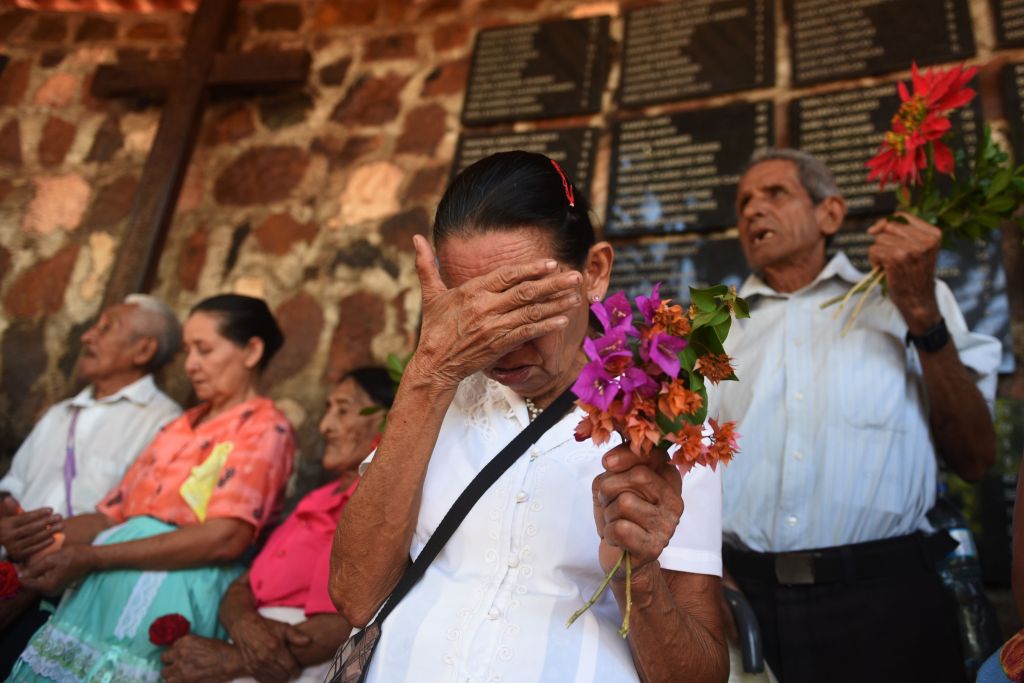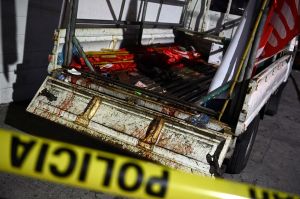An American army officer knew about the largest single massacre in modern Latin American history as it happened, according to blockbuster testimony given by an expert 40 years later.
The execution of some 1,000 people by the military in 1981 during El Salvador’s bloody civil war is one of the country’s darkest chapters, which is now subject of one of the most anticipated and long-awaited legal proceedings in Latin American history.
Videos by VICE
Stanford University political scientist Terry Karl made the stunning allegation in a hotel banquet room, where pre-trial hearings are being held to accommodate spectators. Fifteen retired military officers are facing charges of systematically executing the civilians, half of them children, over the course of four days in the village of El Mozote and nearby towns.
The hearings are unearthing documents long kept secret and shed light on just how involved American officials were in El Salvador’s 12-year civil war, which killed an estimated 75,000 people between 1980 and 1992. The fact that the case is being heard before a judge is itself remarkable, and comes after decades of cover-ups and impunity, as well as the reversal of a Salvadoran law that gave blanket amnesty for all crimes committed during the war.
“The deeper you get into it, the more lies you reveal,” said American journalist Mark Danner, who wrote an investigative book about the massacre. “And what you thought was a level of truth turns out to have a trap door underneath it.”
Describing a “sophisticated cover-up,” Karl alleged in court that American military advisor Allen Bruce Hazelwood was with Domingo Monterrosa, the Salvadoran lieutenant colonel in charge of the operation, as the massacre unfolded. Karl said she believes the American accompanied Monterrosa by helicopter to the massacre site, citing conversations Hazelwood allegedly had with colleagues at the time. “The participation of an advisor in wartime activities is against our laws, and it was illegal at the time,” Karl told the court, according to the Salvadoran news outlet El Faro.
The accusations sparked a heated response from Hazelwood, who has generally refused to talk with the media.
“I had no first-person knowledge before, during or immediately after” the massacre, he wrote in an email to VICE World News. “However, if anything was said years later, it was most likely misunderstood, not true, not first hand, possibly inaccurate and/or would have been influenced from what was read and heard over the years.” He added that “there is no recollection on my part of ever speaking with anyone about the incident, official or unofficial, and there was no sworn interview with anyone that was alluded to during Karl’s testimony.”
But Karl’s evidence is based in part on a secret interview Hazelwood gave to the United Nations’ Truth Commission for El Salvador in the early 1990s, in which said he had “personal knowledge” that as the massacre began, Monterrosa was at the military barracks, and that Monterrosa “went out into the field when ‘things’ were still going on.” Asked whether Monterrosa knew about the killings, Hazelwood responded, “I won’t say that Monterossa didn’t order it.” Monterrosa died in 1984 in a helicopter explosion.
Hazelwood maintained during his testimony to the U.N. — and also in his email to VICE World News — that throughout the massacre, he was some 100 miles away training soldiers for the American-trained and American-armed Atlacatl Battalion, which carried out the slaughter. He also asserted that he “initiated every military program in El Salvador and was a key planner in formulating the national military strategy,” according to the two-page summary of his testimony, which VICE World News reviewed.
Hazelwood refused to divulge more. “When I pressed him on other points, [Hazelwood] changed the subject or said he didn’t know,” the interviewer for the Truth Commission wrote. The testimony stayed secret for nearly 30 years. It appears to have first surfaced as evidence in the case of four Dutch journalists who were murdered in 1982 in El Salvador, and then leaked to journalists.
“We had a U.N. Truth Commission. Now we need an American Truth Commission. What was Hazelwood doing there? What did Americans know at the time? This raises more questions,” said Raymond Bonner, the New York Times reporter who was one of two journalists who broke the story of the El Mozote massacre, infuriating American officials and drawing heated denials.
The facts were horrifying. It began with the Salvadoran military dropping bombs on Mozote and nearby villages, and then soldiers marched in on December 10, 1981 to interrogate residents about leftist guerrilla fighters. The following morning, the soldiers forced everyone to leave their homes and assembled them in the town square. The men and older boys were divided from the women and young children.
After murdering the men, the women were “machine gunned,” according to the Inter-American Court of Human Rights. More than 400 children under the age of 12 were executed.
For decades, the Salvadoran and U.S. governments downplayed the massacre. El Salvador was a central focus of U.S. foreign policy in the 1980s — a proxy for Washington’s battle against communism. Despite reports of massacres, rape, and torture, the U.S. poured more than $4 billion from 1980-1992 into the Salvadoran military and government, which was fighting leftist guerrillas at the time. Elliott Abrams, a senior State Department official during the Reagan administration, told a Senate Committee that the reported numbers of deaths at the massacre were “not credible” and described it as propaganda by the leftist rebels. It’s an “incident that is at least being significantly misused, at the very best, by the guerrillas,” he testified.
But Abrams privately told the former director of Human Rights Watch that an American advisor — presumably Hazelwood — was present during the massacre in Mozote, Karl testified in the pre-trial hearing. Abrams told VICE World News in an email that he doesn’t recall having such a conversation, and denied misleading Congress about the massacre. Abrams was later appointed by former President Donald Trump to serve as the U.S. Special Representative for Venezuela.
“U.S. officials out and out either lied or omitted their knowledge of what was happening,” said Kate Doyle, a senior analyst of U.S. policy in Latin America with the National Security Archives. “The idea of U.S. culpability is not theoretical. This is a fight we helped fuel.”
The top official facing trial for the massacre is retired General José Guillermo García Merino, El Salvador’s defense minister from 1979 to 1983. Granted asylum by the U.S. in 1990, an immigration judge subsequently ordered him deported in 2015 for his role in the country’s human rights abuses. The judge found that the former general, now in his late 80s, had assisted in acts of torture and extrajudicial killings.
Even as the case inches forward, doubts remain about whether the long-awaited trial will actually happen. In September 2020, soldiers blocked Judge Jorge Guzmán, who reopened the investigation into the massacre, from accessing military records regarding the mass killing. Salvadoran President Nayib Bukele, who had previously promised to guarantee access to such records, changed his position and backed the military. He accused the judge of being motivated by “political interests” and said he had “no jurisdiction over the Armed Forces,” according to Human Rights Watch. Bukele added that only he, as president, had authority to declassify the files.
In a sign of his growing autocratic tendencies in the tiny Central American nation, Bukele seized control of the country’s Supreme Court over the weekend and replaced its five top judges, as well as the attorney general. None of that bodes well for the case going to trial, said David Morales, a human rights defender and lawyer for the surviving massacre victims. Even a delay could have significant repercussions — already, three of the accused military officials have died in recent years.
“The victims are peaceful people,” Morales said. “They simply want those responsible for the massacre to face trial.”







